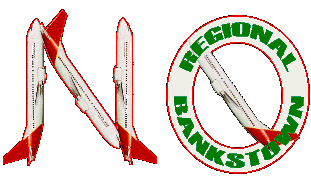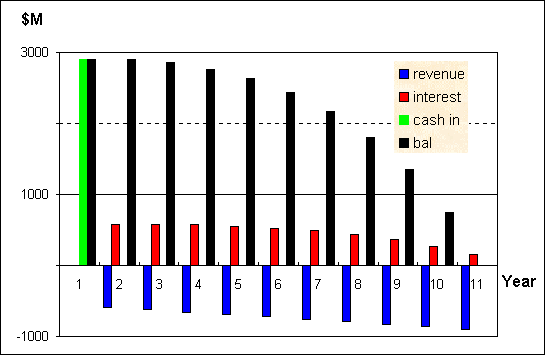|
AFFORDABILITY OF SECOND AIRPORT
Economisc of Who Pays and How Much
|
 |
|
Care to donate $109 towards someone else's next overseas holiday or interstate business trip ? Planners of Sydney's Second Airport are asking Australians for just that in the December 22nd, 1997 Draft EIS for Sydney's Second Airport. When tourism and business chiefs clamour for a Second Airport, their talking about spending someone else's money - YOURS!!! The summary of the Draft EIS shows the Second Airport costs will be huge. Air travellers will be in for a rude shock if they have to pay for this. Will the shock be so big a new airport won't be needed ? Wouldn't that be a victory for the environment ! The independent auditor has highlighted the fact that the Draft EIS's analysis of the airport economics is not adequate for a project of this scale. It provides no cost benefit analysis, and no account of how the funds for the project will be raised and recovered. Let's do some analysis of our own to fill this gap… The economics was addressed somewhat better in
the Final EIS, released 19 months
later on 7th July, 1999. But the discussion here remains
applicable.
Recovering Construction Costs from UsersTable 1 shows the levy (or toll) airport users should be charged if they were to pay just the construction costs of airport expansion. Various interest rate and investment term arrangements are shown (see below for Calculating the Cost):
Table 1 - User Charges for Airport Construction
Cost Recovery
All travellers have to pay an extra $109 per return trip out of Sydney if users are to pay for the airport expansion.
Figure 1 - Cash Flow Diagram (20% / 10 year
scenario)
This toll has to be levied on every passenger using either the existing KSA or the future Second Airport, right now in order to encourage more efficient allocation of airport resources. Delaying the charge will only make it higher. But can you imagine the outcry from air travellers if this levy were imposed tomorrow ? Short-range air travel would be priced to extinction (e.g. Goulburn, Orange, Newcastle, Wagga). Interstate and overseas travel would also take nasty hits. The EIS predictions of airport growth begin to look pretty sick, and even higher charges would be needed. If an aircraft movement levy is struck instead of a passenger-based levy, it becomes clear that smaller aircraft (say 40 or fewer seats) are unlikely to be viable. Where will they go ? What environmental and financial impacts will they take with them ? Is the real plan to expand Bankstown and other general aviation airports to leave more room at KSA for the big stuff ? Are plans for more traffic at Bankstown Airport during the Olympics going to become Sydney's permanent solution to it's airport problems ? Calculating the CostCapitalThe Second Airport Summary EIS lists the Badgerys Creek option C as costing from $4.4 billion to $5.8 billion, in 1997 dollars. What user levy is needed to fund (amortize) this ? The EIS figure is the estimated cost of constructing the 2016-scale airport in 1997 (PPK communication 11/9/97). It is not based on a properly constructed cash flow analysis, showing when funds need to be committed. To correct this, assume the airport will be built in two stages. The second stage will be built 10 years after the first (and might comprise the second runway etc.,.). Also estimate that the predicted expansion of KSA by 10 million passengers p.a. will cost approximately 1/3 of the 30 million passenger p.a. airport planned for Badgerys Creek. The user charge will have to repay the debt and equity borrowing which finance the building works. To calculate the charge, estimates have to be made of the term for the investments, and the appropriate interest rates to use. Interest Rate SelectionFor government projects, interest rates close to actual commercial loan rates are used. Currently the NSW treasury requires a discount rate of 10% to be applied to capital works. For a privately owned/operated project, higher rates are needed to induce investors to risk their money. Private equity holders will require a profit, often much higher than the 10% cost of funds. These are needed firstly to attract their funds away from other profitable investments. A private sector company will also have to pay company tax. Then, premiums have to be added for the risks due to uncertainties with oil supplies and possible competing forms of transport in the future. Inflation and risks due to political changes have also to be accounted for. Estimating these premiums is difficult - most businessmen regard information on these as commercial-in-confidence stuff - secret businessmen's code for "you're not grazing in my paddock". Many business investors look for rates of return in the vicinity of 20 to 30 % and higher (it's not hard finding portfolio's offering 25% rates currently). The correct discount rate may lie between 10 and 30 %. Let's consider a conservative range of discount rates from 10% to 20%. Investment TermThe term of the investment is also difficult to estimate. It's hard to prepare reliable business plans extending beyond 10 years - even the Summary EIS makes little attempt to estimate beyond 20 years (2016). Longer terms need higher risk premiums, and incur additional refinancing costs, which offset the benefit of otherwise lower repayments. To cover these uncertainties, consider two terms: 10 years, and 20 years (remember, jumbo's haven't been around 30 years, and probably won't be around in another 30 years). RepaymentFor each interest/term pair of values, an annual repayment can be calculated. A user-pays levy can be arrived at in various ways:
A user charge is shown in Table 1 for each of these cases. The table assumes that users of both KSA and the Second Airport will be tolled (to equalize the burden), and the toll will be fixed in real terms. It is expressed in 1997 dollar terms, so keep in mind it will rise in line with inflation as the years roll by. The EIS's prediction of passenger numbers is used to calculate the toll. Passenger numbers are multiplied by the toll, and paid off annually against the loan, so that the balance reaches zero at the end of the required term (see the cash flow diagram). The terminal gate entry exit levy is arrived at by assuming a fixed proportion of passengers do not embark or disembark at Sydney. As most passengers fly on return tickets, the terminal gate entry/exit levy in Table 1 is scaled into the Return Ticket Levy. An adjustment to also include the KSA expansion costs is included in the figure shown (other figures do not include KSA expansion costs). Other Costs & SimplificationsThe analysis here is illustrative, and not intended to represent all the costs and benefits of an airport project. It is incremental, showing the impact of new construction works on airport finances. Even if we accept claims that current airport operations are profitable, the cost of financing new construction works casts considerable doubt that this will continue to be the case. Are they profitable only in the sense that taxpayers accept lower rates of return that private operators would ? Some of the simplifications in the above analysis are:
Worst-Case Financing ?If you think the choice of a 10 year / 20 % financing arrangement is extreme, how much money have you got to lend me at the lower rates you think are fair ? If you happen to be a wealthy banker or rich oil sheik, and you'd be happy to invest $3 billion in an airport for just 15% over 20 years, contact me urgently. Don't worry too much about what happens to your 15% return if inflation takes off towards 10% some time in the next 20 years ! Taxpayer's RoleWhy has the airport debate avoided the basic questions of who pays and how much ? Will government secretly commit taxpayer's to pouring giga-dollar subsidies into the aviation and tourism industries ? Australia has only 9 million people in employment (with miserable prospects for growth). This is under half the number of passengers the airport cost is spread over in the above analysis. Each worker would have to contribute around $250 per annum in taxes. Can such use of taxpayer's money be justified ? Could every air traveller generate so much business that other taxes they pay offset the airport costs ? Tourism Council statistics (hardly an unbiased source) claim each overseas tourist spends $2,200. How much of this does the taxman capture, how much other infrastructure must it support, and what about the business and local tourist who make up 80% of travellers ? Proposals for a 10% GST clearly won't be enough (10% of $2,200 is $220, leaving a $30 shortfall ! ) Does an airport offer the best possible return on taxpayer's dollars ? Or would it be better spent on health, education, export creation schemes or other worthy projects ? To date, the EIS process gives no answer to these questions. There is no basic answer to the question of whether this airport is necessary, affordable or desirable. If the government can't answer this in the EIS, maybe it's time to leave it to the marketplace to sort things out. Tell the tourism and aviation folks to NAFF-OFF and spend their own money on the airport, if it's such a great idea. First published June 1998.
Last revised
Last Change: vdeck mod Visitor
since Sat 21-Feb-2004.
|
|||||||||||||||||||||||||||||||||||||||||||||||||||||||||||||||
